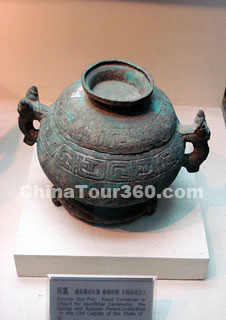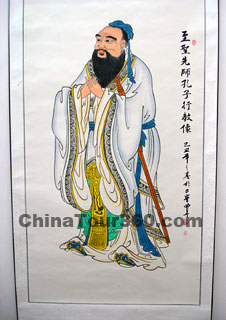 |
| A Bronze Pot |
The Spring and Autumn period is named after a book called the Spring and Autumn Annals, a chronicle of the state of Lu between 722 BC and 481 BC, which tradition associates with Confucius . It was a period of turbulence and changes in the economy, politics, and military affairs. In Chinese history, it was a period which roughly corresponds to the first half of the Eastern Zhou dynasty (from the second half of the 8th century BC to the first half of the 5th century BC).
During that period, China was ruled by a feudal system. The Zhou dynasty kings held nominal power, but only directly ruled over a small Royal Domain, revolving around their capital (currently Luoyang). The status of the Emperor was diminished to little more than that of a figurehead, while powerful nobles gradually extended their dominions over smaller neighboring states. According to recorded history, during the Spring and Autumn Period, there were over 480 wars, 52 vassal states were vanquished, and 36 kings were killed.
By the sixth century B.C., most small states had disappeared, and a few large and powerful principalities dominated China. Some southern states, such as Chu and Wu, claimed independence from the Zhou. Wars were undertaken to oppose some of these states-Wu and Yue. In the state of Jin, six powerful families fought for supremacy, and a series of civil wars resulted in the splitting of Jin into three smaller states by the beginning of the fifth century B.C. At that time, the control Zhou kings exerted over feudal princes was greatly reduced, the feudal system crumbled, and the Warring States Period began.
 |
| A Portrait of Confucius |
During the Spring and Autumn Period, a complex system of interstate relations developed and many projects requiring the collaboration of two or more states were undertaken, such as drainage operations, canals, dikes, reservoirs, and roads. Massive walls were built, both as protection from each other and from aboriginal and nomadic tribes, which was the earliest Great Wall in China.
The Spring and Autumn Period was also considered as a period of philosophies: Daoism, Confucianism, and Legalism originated during that period. Many important cultural developments took place, and great Chinese thinkers including Confucius, founder of Confucianism; Laozi, founder of Daoism; and Mozi, founder of Mohism developed the philosophical systems which have shaped North Eastern Asia until the present day.
Region was not appeared in a large scale. Buddhism and Taoism were both appeared in China during the Han Dynasty (206BC - 220AD). Carved bronze wares represent the art of the period. A bronze vessel with three feet and a sheep head is the most famous one. The Yin-yang and five-element theory was formed during the Spring and Autumn Period. The theory interpreted the whole world with the five-element system.
![]() Go to the Warring States Period
Go to the Warring States Period







